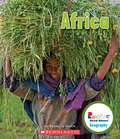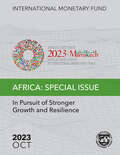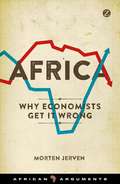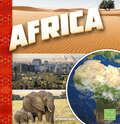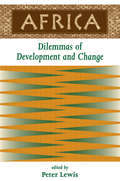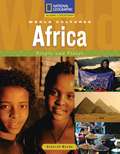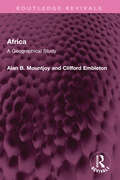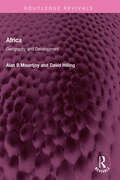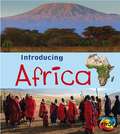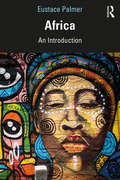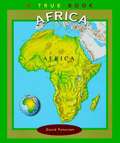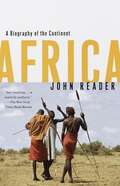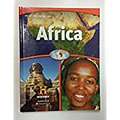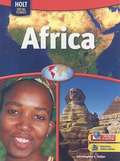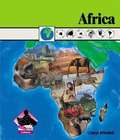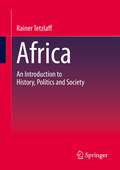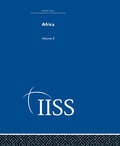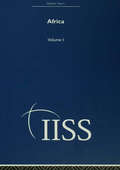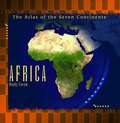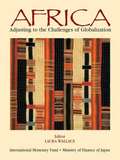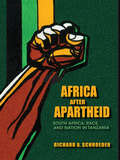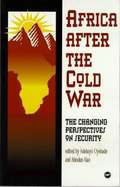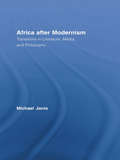- Table View
- List View
Africa (Rookie Read-About Geography)
by Rebecca E. Hirsch<p>Get ready for a fascinating trip around the seven continents of the world! Simple, engaging text and colorful, mesmerizing pictures teach you about each continent's land features, populations, native animals, technological advances, and lots more—including how to find each continent on a map! <p>Africa is a large and diverse continent, and young readers will love discovering the people, geography, and animals found there.</p>
Africa: In Pursuit Of Stronger Growth And Resilience (Regional Economic Outlook Ser.)
by International Monetary Fund. African Dept.,International Monetary Fund. Middle East and Central Asia Dept.A report from the International Monetary Fund.
Africa: Why Economists Get It Wrong (African Arguments)
by Morten JervenNot so long ago, Africa was being described as the 'Hopeless Continent'. Recently, though, talk has turned to 'Africa Rising', with enthusiastic voices exclaiming the potential for economic growth across many of its countries. What, then, is the truth behind Africa's growth, or lack of it? In Is Africa Rising?, Morten Jerven fundamentally reframes the debate, challenging mainstream accounts of African economic history. Whilst for the past two decades experts have focused on explaining why there has been a 'chronic failure of growth' in Africa, Jerven shows that most African economies have been growing at a rapid pace since the mid-90s. In addition, African economies grew rapidly in the 50s, the 1960s, and even into the 1970s. Thus, African states were dismissed as incapable of development based largely on observations made during the 1980s and early 1990s. The result has been misguided analysis, and few practical lessons learned. An essential account of the real impact economic growth has had on Africa, and what it means for the continent's future.
Africa: A 4d Book (Investigating Continents Ser.)
by Christine JuarezCome along and investigate the continent of Africa. What are its biggest cities? Where is its tallest mountain? What languages do people speak there? Bring augmented reality to your students by downloading the free Capstone 4D app and scanning for access to awesome videos!
Africa: Dilemmas of Development and Change
by Peter LewisEssays on common problems and challenges evident during four decades of postindependence development in Africa.
Africa: Dilemmas of Development and Change
by Peter LewisIn the decades since independence, the countries of sub-Saharan Africa have faced three central dilemmas of development. The first has been the challenge of state building. In the wake of colonial rule, governments have encountered the problems of establishing legitimate authority and constructing capable states. A second dilemma has been that of nation building and state-society relations. African countries have confronted the difficulties of managing ethnic diversity, forging national identities, and negotiating relations between citizens and rulers. The third challenge encompasses problems of economic development as the region has grappled with a legacy of poverty, slow growth, and external dependence.This collection provides an overview of the leading themes and issues in these three critical areas of Africa's postindependent development. A selection of pathbreaking articles provides insights into the key questions, the major theories, and the outstanding challenges in African development. Written by today's most influential African scholars, the readings cover a variety of topics including political leadership; forms of state power; the role of civil society; the importance of class, ethnicity, and gender; and the prospects for democratic change in the region. Changes in African political economies are also addressed, focusing special attention on the debt crisis and the problems of economic reform. A final section focuses on the present-day challenges to African development: the spread of refugees, pressures on the environment, the devastating toll of AIDS, and the threat of state collapse.Providing a broad historical perspective on Africa's political and economic development and an overview of current problems and prospects, this collection will be especially useful for advanced undergraduates, graduate students, and development professionals.
Africa: People and Places (World Cultures)
by Deborah MeadeEncourage students to look through the book, matching cultural themes such as Arts and Sports with the titles of articles. Urge them to pay special attention to the photographs, captions, graphics, and article summaries. Tell students Explain that Africa: People and Cultures presents a series of articles that combine to produce a broad picture of Africans ways of life.
Africa: A Geographical Study (Routledge Revivals)
by Alan B Mountjoy Clifford EmbletonFirst published in 1965, Africa provides a geographical, political, economic and social description of the continent. Contemporary Africa is a continent of change and revolutions. The diversity and limitations of the African environment gives us a fuller understanding of the explosive dynamism of the African economic and social scene. This book will be of interest to students of geography, economy, anthropology and political science.
Africa: Geography and Development (Routledge Revivals)
by Alan B Mountjoy David HillingFirst published in 1988, Africa examines the varied pattern of development in the continent, the progress and the disappointments experienced, and the prospects. This picture is set firmly within the frame of the continent’s geography. From a general synthesis, the books moves to a country by country analysis of the interdependence of geography and economic development. The authors’ analysis of the effects of varied development strategies in Africa leads them, in the final section, to discuss what lessons maybe learned from these earlier initiatives and to assess the changes in development policies that were later implemented. This book will be of interest to students of geography, economics and development studies.
Africa (Introducing Continents)
by Chris OxladeTopics covered within the book include where the continent is, climate, geography, animals and plants, countries, people and languages, natural resources, cities, and famous places.
Africa: An Introduction
by Eustace PalmerAfrica: An Introduction invites you into Africa: a continent rich with culture and history, with diverse populations stretching from the dense tropical rain forest of the Congo basin, right up to the Sahara Desert in the north, and down to the Mediterranean climates of the far south. Containing fifty-five countries, and covering over 20 percent of the world’s landmass, Africa is the birthplace of humanity, yet the image of Africa in the West is often negative, that of a continent riddled with endemic problems. This accessible and engaging guide to the African continent guides the reader through the history, geography, and politics of Africa. It ranges from the impact of slavery and imperialism through to the rise of African nationalism and the achievement of independence, and up to the present moment. Key topics covered include literature, art, technology, religion, the condition of African women, health, education, and the mounting environmental concerns faced by African people. As Africa moves beyond the painful legacies of slavery and imperialism, this book provides an engaging, uplifting, and accessible introduction to a rapidly modernizing and diverse continent. Suitable for high school and undergraduate students studying Africa, this book will also serve as the perfect introduction for anyone looking to understand the history of Africa and the Africa of today.
Africa: A True Book
by David PetersenIdeal for today's young investigative reader, each A True Book includes lively sidebars, a glossary and index, plus a comprehensive "To Find Out More" section listing books, organizations, and Internet sites. A staple of library collections since the 1950s, the new A True Book series is the definitive nonfiction series for elementary school readers.
Africa: A Biography of the Continent
by John ReaderIn 1978, paleontologists in East Africa discovered the earliest evidence of our divergence from the apes: three pre-human footprints, striding away from a volcano, were preserved in the petrified surface of a mudpan over three million years ago. Out of Africa, the world's most ancient and stable landmass, Homo sapiens dispersed across the globe. And yet the continent that gave birth to human history has long been woefully misunderstood and mistreated by the rest of the world. <p><p> In a book as splendid in its wealth of information as it is breathtaking in scope, British writer and photojournalist John Reader brings to light Africa's geology and evolution, the majestic array of its landforms and environments, the rich diversity of its peoples and their ways of life, the devastating legacies of slavery and colonialism as well as recent political troubles and triumphs. Written in simple, elegant prose and illustrated with Reader's own photographs, this is an unforgettable book that will delight the general reader and expert alike.
Africa
by Cheryl StriveildiA very brief introduction to the geography, various regions, and wildlife of Africa.
Africa: An Introduction to History, Politics and Society
by Rainer TetzlaffThe textbook provides an in-depth overview of African history and politics from the Atlantic slave trade, through the phases of colonialism and decolonization, to the development problems of the present. Various development theories are used to explain successful and failed development paths of individual countries after 1960. Thematic foci include Europe's colonial legacy, state formation and state failure, democratization, the curse of raw materials, population growth, hunger and poverty, ethnic conflicts, and the roles of the World Bank, EU, and China as external actors in Africa.
Africa: Volume 2 (Adelphi Papers Reissue Hardback)
by variousComplete set Since 1961 the Adelphi Papers have provided some of the most informed accounts of international and strategic relations. Produced by the world renowned International Institute of Strategic Studies, each paper provides a short account of a subject of topical interest by a leading military figure, policy maker or academic. The project reprints the first forty years of papers, arranged into thematic sets. The collection as a whole provides a rich and insightful account of international affairs during a period which spans the second half of the Cold War, the fall of the communist bloc and the emergence of a new regime with the United States as the sole superpower. There is a wealth of global coverage: Four volumes on east and southeast Asia as well as individual volumes on China, Japan and Korea Particular attention is given to the Middle East, with volumes addressing internal sources of instability; geo-politics and the role of the superpowers; the Israel-Palestine conflict; and the Iran-Iraq War and the first Gulf War. There is also a volume on oil and insecurity There are also two volumes on Africa, the site of most of the world’s wars during the period The IISS has obviously made a particular contribution to the understanding of military strategy, and this is reflected with material on topics such as urban and guerrilla warfare, nuclear deterrence and the role of information in modern warfare. Volumes on military strategy are complemented by approaches from other disciplines, such as defence economics. Key selling points: Early papers were only distributed by the IISS and will have achieved limited penetration of the academic market A host of major authors on a range of different subjects (eg Gerald Segal on China, Michael Leifer on Southeast Asia, Sir Lawrence Freidman on the revolution in military affairs, Raymond Vernon on multinationals and defence economics) Individual volumes will have a strong appeal to different markets (eg the volume on defence economics for economists, various volumes for Asian Studies etc)
Africa: Volume 1 (Adelphi Papers Reissue Hardback)
by variousComplete set Since 1961 the Adelphi Papers have provided some of the most informed accounts of international and strategic relations. Produced by the world renowned International Institute of Strategic Studies, each paper provides a short account of a subject of topical interest by a leading military figure, policy maker or academic. The project reprints the first forty years of papers, arranged into thematic sets. The collection as a whole provides a rich and insightful account of international affairs during a period which spans the second half of the Cold War, the fall of the communist bloc and the emergence of a new regime with the United States as the sole superpower. There is a wealth of global coverage: Four volumes on east and southeast Asia as well as individual volumes on China, Japan and Korea Particular attention is given to the Middle East, with volumes addressing internal sources of instability; geo-politics and the role of the superpowers; the Israel-Palestine conflict; and the Iran-Iraq War and the first Gulf War. There is also a volume on oil and insecurity There are also two volumes on Africa, the site of most of the world’s wars during the period. The IISS has obviously made a particular contribution to the understanding of military strategy, and this is reflected with material on topics such as urban and guerrilla warfare, nuclear deterrence and the role of information in modern warfare. Volumes on military strategy are complemented by approaches from other disciplines, such as defence economics. Key selling points: Early papers were only distributed by the IISS and will have achieved limited penetration of the academic market A host of major authors on a range of different subjects (eg Gerald Segal on China, Michael Leifer on Southeast Asia, Sir Lawrence Freidman on the revolution in military affairs, Raymond Vernon on multinationals and defence economics) Individual volumes will have a strong appeal to different markets (eg the volume on defence economics for economists, various volumes for Asian Studies etc)
Africa (The Atlas Of The Seven Continents Series)
by Wendy VierowAfrica is a continent of 53 countries and is home to people who make up more than 800 ethnic groups. More than 5,000 years ago, the country of Egypt, located in northern Africa, was one of the world s greatest civilizations. Africa is the land of the Sahara, the world s largest desert. It also hosts the Democratic Republic of Congo, which has one of the world s thickest rain forests. Many important natural resources, from exotic animals to precious minerals such as oils and diamonds, can be found in Africa.
Africa: A Beginner's Guide (Beginner's Guides)
by Tom YoungVast, diverse, dynamic, and turbulent, the true nature of Africa is often obscured by its poverty-stricken image. In this controversial guide, Tom Young cuts through the emotional hype to critically analyse the continent's political history and the factors behind its dismal economic performance. Maintaining that colonial influences are often overplayed, Young argues that much blame must lie with African governments themselves and that Western aid has often caused more harm than good.
Africa after Apartheid: South Africa, Race, and Nation in Tanzania
by Richard A. SchroederTracing the expansion of South African business into other areas of Africa in the years after apartheid, Richard A. Schroeder explores why South Africans have not always made themselves welcome guests abroad. By looking at investments in Tanzania, a frontline state in the fight for liberation, Schroeder focuses on the encounter between white South Africans and Tanzanians and the cultural, social, and economic controversies that have emerged as South African firms assume control of local assets. Africa after Apartheid affords a penetrating look at the unexpected results of the expansion of African business opportunities following the demise of apartheid
Africa After The Cold War: The Changing Perspectives On Security
by Adebayo Oyebade Abiodun AlaoAlthough it is widely recognized that Africa's security problems are acute, it has never been a subject of much intellectual inquiry. This lack of scholarly discourse on the many dimensions of the problem of African security is the major consideration for this book. The approach to the question of security in this book differs markedly from the traditional approach that gives primacy to the threat of military aggression as sole factor in state security. A departure must be made from this dominant preoccupation in a new global order that has seen profound changes. The authors then place primacy on the complex problems of ethno-religious nationalism, economic stagnation, catastrophic civil wars, environmental degradation and the prospects for democratic structures in considering Africa's security issues after the Cold War.
Africa after Modernism: Transitions in Literature, Media, and Philosophy (Routledge Studies in Cultural History)
by Michael JanisAfrica after Modernism traces shifts in perspectives on African culture, arts, and philosophy from the conflict with European modernist interventions in the climate of colonialist aggression to present identitarian positions in the climate of globalism, multiculturalism, and mass media. By focusing on what may be called deconstructive moments in twentieth-century Africanist thought – on intellectual landmarks, revolutionary ideas, crises of consciousness, literary and philosophical debates – this study looks at African modernity and modernism from critical postcolonial perspectives. An effort to sketch contemporary frameworks of global intersubjective relations reflecting African cultures and concerns must resist taking modernism as a term of African periodization, or master-narrative, but as a constellation of discursive and subjective forms that obtains upon the present moment in African literature, philosophy, and cultural history. Africa after Modernism argues for a philosophical consciousness and pan-African multiculturalist ethos that operate, after the deconstruction of Eurocentrism, beyond self/other paradigms of exoticism or West/Africa political ideologies, in dialogue with postcolonial approaches to cultural reciprocity.
